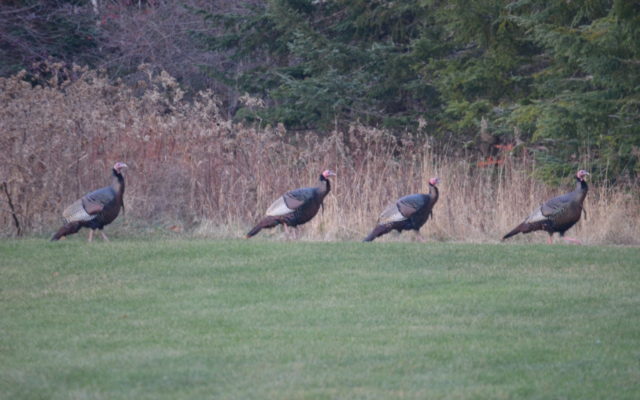There are many more wild turkey hunters throughout Aroostook County than most people might guess. I’ve been trying to outsmart wily gobblers for about 25 years, mostly in southern Maine, but also in Florida, Hawaii, New Hampshire and Vermont. Calling a long-beard Tom turkey into shotgun range is an exciting and challenging endeavor, and well worth the time and effort of traveling that hundreds of northern Maine sportsmen endure.
This month, thanks to increasing numbers and expanding territory, Crown of Maine gunners can hunt close to home in zones 1-6 and expect dependable action. It should be noted that by the late 1800s, Maine’s turkey population was nearly extinct. Attempts were made in the early 1940s and i

The season is now open for wild turkey hunting throughout Aroostook, and local folks no longer need to travel south to bag a big Tom turkey. It’s a great opportunity to introducd a son or daughter to a new sport. Buddy, left, and Brian Horr share in memorable youth day outing. (Courtesy of Bill Graves)
n the 1960s to reintroduce birds in several areas, but none succeeded in establishing wild populations. In 1977 and 1978, wildlife biologists transferred 41 Vermont turkey to the York and Eliot region and modern flocks took hold.
Further growth and northward expansion took place with the transplant of 70 Connecticut wild turkeys in 1987 and 1988. Flocks grew so quickly in milder winter areas of southern Maine and along the coast that turkey actually became a nuisance on many farms. Aroostook, however, with its deep snow and frigid temperatures, made winter foraging a challenge for the gobblers and local flocks were slower to establish, with zones 1-6 open to hunting for the first time in 2014.
With the expansion of hunting areas and burgeoning population of wild turkey, many rules and regulations have been altered over the last few seasons. Most offer a convenience or benefit to the sportsmen and each hunter needs to be aware of the changes. For example, originally it was necessary to apply for a permit and hope to be drawn. Now everyone can purchase a turkey license. The legal hunting hours extended from legal light until noon, but now gunners can hunt all day, and there’s a spring and fall season in selective zones. It’s now legal to take more than one bird, two bearded turkey in the spring and two of either sex in the fall in certain zones as well.
Here in Aroostook, youth day actually began the season on April 28, and a split season for all other hunters opened April 30. Since 2018 is an even numbered year, hunters born in any even number year, say 1968 or 2002, get to hunt season A. Hunters born in odd numbered years hunt season B, two alternate weeks, and everyone who hasn’t filled a turkey tag can hunt the last full week from May 28 through June 2. Due to local weather conditions here in the Crown of Maine, especially this spring, the last three weeks will likely be the most productive.
Most regional sportsmen who hunt upland birds or waterfowl will already be mostly equipped to go after a gobbler. Any scattergun from 20-gauge to 10-gauge is legal using shells loaded with size 4 to size 7 pellets. Camo clothing is a must to hide from these keen-eyed birds, especially gloves and a face mask, and use of natural cover, a makeshift hedge row or field edge blind, or a portable pop-up commercial blind offer further cover.
Perhaps the two most essential pieces of gear to ensure success drawing a wary Tom within shotgun range at 35 yards or less are lifelike decoys and realistic calling. At least one full size hen decoy will help draw an amorous male close and keep his attention from nearby blinds and hunters. I have a friend who guides professionally and swears by a three decoy set up, including a standing hen, a squatting hen and a strutting jake, to stoke the fires of love and jealousy in an approaching Tom.
There’s little doubt that an electronic call offers realism, variety and perfection, especially for novice turkey hunters, but many other options are available for the more hands-on sportsman. Box calls, slate calls and diaphragm mouth calls offer a wide variety of very realistic hen and Tom turkey sounds. But these require time and effort to perfect. You need to coax the gobbler closer, not scare him away. Until one of the three preferred calls is perfected, the electronic type, a shaker style or push-button box will serve your purpose, especially on younger birds.
Last but not least, beyond the gear I’ve mentioned, the foundation of successful turkey hunting is scouting. This is even more crucial throughout Aroostook with so much open land and fewer turkeys. These big birds can roam miles in a day searching for food, but will often remain in one area when a good feed plot is found. Any field that attracts turkey in the afternoon will likely bring them back the next morning. This can be confirmed by watching the gobblers fly into nearby roost trees for the night at sundown.
Aroostook outdoorsmen have always had the option of going wild turkey hunting, but it required travel south, securing accommodations and permission to hunt where most land is posted. The other option was to locate and pay a guide. Now regional hunters can pursue gobblers right near home just as they would with other big game, and a pre-work outing is certainly possible. It’s prime time right now for an exciting challenge and tasty table fare. Let’s talk turkey!
- This quartet of big Toms were among a flock of 11 birds spotted by the author while scouting near Washburn. Aroostook County’s wild turkey population is growing and spreading each year. (Bill Graves)





